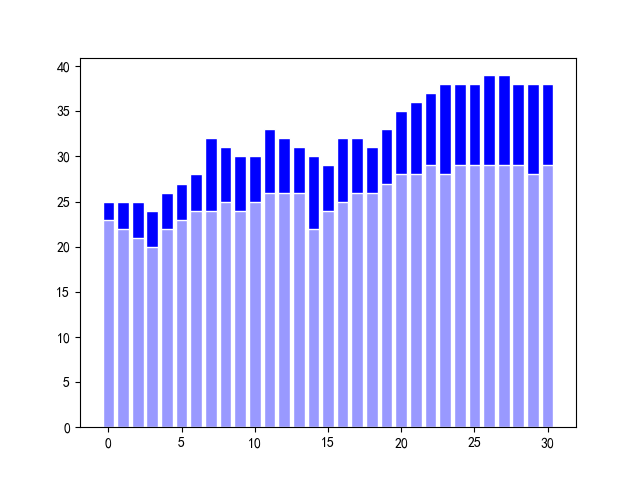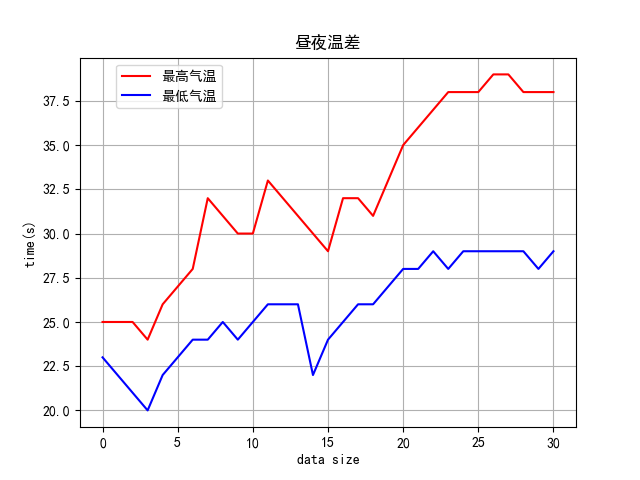爬虫实战 —— 天气网合肥地区天气数据
抓取天气网中合肥地区11年到18年所有天气数据,并对输出的数据进行可视化。
目标网址:http://lishi.tianqi.com/hefei/index.html
一 抓取网站数据代码如下:
import requests import re from bs4 import BeautifulSoup import time def get_response(url): try: r = requests.get(url) r.raise_for_status() r.encoding = r.apparent_encoding return r.text except: print('') #获取每年中每月的数据的链接,并将其保存在u_list里面 def get_year_href(r): u_list = [] soup = BeautifulSoup(r,'lxml') res = soup.find('div','tqtongji1').contents a_soup = BeautifulSoup(str(res),'lxml') a = a_soup.find_all('a') for each in a: u_list.append(each.get('href')) return u_list #根据获得每一月的链接,分别抓取每个链接对应的数据 def write_month_weather(url): r = requests.get(url).text soup = BeautifulSoup(r,'lxml') #保存每一天的数据的div,class = tqtongji2 weather_res = soup.find('div',class_ = 'tqtongji2') #进一步解析weather_res ul_soup = BeautifulSoup(str(weather_res),'lxml') ul_list = ul_soup.find_all('ul') """ 2017年12月的url:http://lishi.tianqi.com/hefei/201712.html 可以使用split()方法获得201712.html, 再用正则表达式获取201712进行简单的文件命名: date = re.compile(r'[\d]*') mo = date.search(url.split('/')[-1]) file_name = mo.group() + '.csv' """ date = re.compile(r'[\d]*') mo = date.search(url.split('/')[-1]) file_name = mo.group() + '.csv' #将每个月的数据保存到excel文件当中 with open(file_name,'w+') as f: for ul in ul_list: li_soup = BeautifulSoup(str(ul),'lxml') li_list = li_soup.find_all('li') try: for each in li_list: """ 运行代码后在抓取到2016年08月的数据之后报错: TypeError: unsupported operand type(s) for +: 'NoneType' and 'str' 这是因为从2016年08月开始,后面的部分数据可能出现为None类型的情况。 我的处理如下: (1)将None改为'空' if each.string == None: each.string = '空' else: pass (2)直接使用Python的异常处理忽略掉。 """ #用逗号分隔 str_w = each.string + ',' f.write(str_w) except: f.write('\n') #continue要在for循环里面使用 continue f.write('\n') def main(): url = "http://lishi.tianqi.com/hefei/index.html" r = get_response(url) u_list = get_year_href(r) for i in range(len(u_list)): write_month_weather(u_list[i]) print(u_list[i]) time.sleep(1) main()
二 对生成的数据进行可视化
使用柱状图和折线图分别表示(以201607的数据为例)
# -*- coding: GBK-*- # #编码问题 import pandas as pd import matplotlib.pyplot as plt import numpy as np """ 使用中文做label的时候,会出无法显示的问题,中文标签全部变成了小方格。 产生中文乱码的原因就是字体的默认设置中并没有中文字体, 所以我们只要手动添加中文字体的名称就可以了。 """ from pylab import * mpl.rcParams['font.sans-serif'] = ['SimHei'] ##a = np.loadtxt(open("201607.csv","rb"),delimiter=",") file = pd.read_csv('201607.csv',encoding="gbk") #分别获取最高气温和最低气温 df1 = file.iloc[:,1:2] df2 = file.iloc[:,2:3] #获取折线图的横纵坐标 x = df1.index y1 = df1[u"最高气温"] y2 = df2[u"最低气温"] """ 也可以使用柱状图表示温差,代码如下: plt.bar(x,y1,width=0.8,facecolor="blue",edgecolor="white") plt.bar(x,y2,width=0.8,facecolor="#9999ff",edgecolor="white") plt.show() """ plt.title('昼夜温差') plt.xlabel('data size') plt.ylabel('time(s)') plt.plot(x, y1,'r', label='最高气温') plt.plot(x, y2,'b',label='最低气温') plt.legend(bbox_to_anchor=[0.3, 1]) plt.grid() plt.show()
运行结果如下图:
(1)柱状图

(2)折线图



